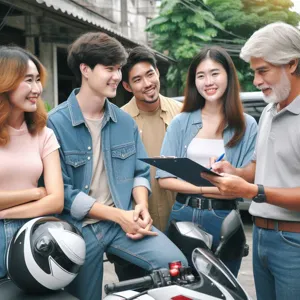Embarking on the thrilling journey of motorcycle riding is a dream for many—freedom on two wheels, the wind in your hair, and the open road ahead.
However, before you can revel in the exhilaration of cruising down scenic highways, you need to navigate the process of obtaining your motorbike license. This essential step not only ensures your safety on the road but also empowers you with the skills and knowledge to handle your bike with confidence. In this comprehensive guide, we will walk you through each stage of getting your motorbike license, from understanding the requirements and preparing for written tests to mastering the practical skills needed for the road. Whether you’re a complete novice or looking to upgrade your existing license, our step-by-step approach will equip you with everything you need to rev up your ride and embrace the adventure that awaits. So, gear up and let’s hit the road to your motorbike licensing journey!
1. Understanding the Importance of a Motorbike License

Before you embark on your journey to obtaining a motorbike license, it’s crucial to understand the significance of this certification. Riding a motorbike is not just about the thrill and freedom it offers; it comes with an essential responsibility to yourself, other road users, and the law. A motorbike license serves as a formal acknowledgment of your skills and knowledge, ensuring that you are equipped to handle a motorcycle safely and efficiently.
First and foremost, possessing a valid motorbike license is a legal requirement in most countries. Riding without one can lead to severe penalties, including hefty fines, points on your driving record, or even the confiscation of your bike. Beyond avoiding legal issues, a motorbike license demonstrates your commitment to safe riding practices. It indicates that you have undergone the necessary training and have passed the required tests to prove your competence on the road.
Moreover, obtaining a motorbike license can enhance your confidence as a rider. The process typically involves a combination of classroom instruction and hands-on training, allowing you to learn essential skills such as navigating traffic, understanding road signs, and executing emergency maneuvers. This training not only prepares you for the practicalities of riding but also instills a deeper understanding of motorcycle mechanics and maintenance, enabling you to care for your bike effectively.
Additionally, having a motorbike license can open doors to new experiences, such as group rides, motorcycle events, and even insurance benefits. Many insurance companies offer lower rates for licensed riders, recognizing the reduced risk associated with those who have completed their training.
In essence, your motorbike license is more than just a piece of identification; it’s a testament to your readiness to embrace the exhilarating world of motorcycling responsibly. So, as you set out on this path, remember that the journey toward obtaining your motorbike license is not just about the destination—it’s about becoming a skilled and conscientious rider who can enjoy the open road with confidence and safety.
2. Types of Motorbike Licenses Explained
When it comes to obtaining your motorbike license, understanding the different types available is crucial to ensuring you select the right one for your riding aspirations. Motorbike licenses vary by region, but they generally fall into a few common categories, each tailored to different levels of experience and types of motorcycles.
**1. Learner’s Permit:**
This is typically the first step for new riders. A learner’s permit allows you to practice riding under certain restrictions, such as not riding after dark or carrying passengers. It’s designed to give you the opportunity to develop your skills while under the supervision of a licensed rider. This is an essential phase where you can get accustomed to the controls and handling of a motorbike before taking on more responsibilities.
**2. Restricted License:**
Once you’ve gained some experience and confidence, you can apply for a restricted license. This type of license may impose certain limitations, such as a maximum engine size or restrictions on riding during nighttime. It’s a transitional step that allows you to ride solo but still emphasizes the importance of safety and skill development. Many regions require a certain period of holding a restricted license before you can upgrade to a full license.
**3. Full License:**
A full motorbike license is what many riders ultimately aspire to achieve. With this license, you can ride any motorcycle without restrictions. To obtain a full license, you typically need to demonstrate advanced riding skills through a practical exam that assesses your ability to handle a motorbike in various conditions. This license signifies that you have met all the necessary training and testing requirements, allowing you the freedom to explore the open road.
**4. Specialty Licenses:**
In addition to the standard licenses, some regions offer specialty licenses for specific types of motorcycles, such as trikes or sidecars. These licenses ensure that riders are equipped with the knowledge and skills to operate these unique vehicles safely.
Understanding these types of motorbike licenses is essential as you embark on your journey to becoming a skilled rider. Each category is designed to promote safety and responsible riding, so be sure to choose the path that aligns with your experience level and riding goals. As you progress through these stages, you’ll not only gain the necessary credentials but also the confidence to navigate the roads with ease.
3. Assessing Your Readiness to Ride

Before you dive headfirst into the exhilarating world of motorcycling, it’s crucial to take a moment to assess your readiness to ride. Riding a motorbike is not just about the thrill of the open road; it requires a combination of physical skill, mental preparedness, and understanding of the responsibilities that come with handling a powerful machine.
Start by evaluating your comfort level with operating a two-wheeled vehicle. Have you ridden a bicycle recently? The balance and coordination you developed while cycling can provide a solid foundation for motorbiking. If you find yourself feeling at ease on a bike, that’s a promising sign. However, if the thought of maneuvering a motorbike makes you anxious, it might be worth investing time in a basic riding course or practicing on a smaller scooter before committing to a full-sized motorcycle.
Next, consider the physical demands of riding. Motorcycling requires strength, agility, and stamina. Are you physically fit enough to handle the demands of riding, especially in varying weather conditions? A quick assessment of your fitness level can help you determine if you need to work on your endurance or muscle strength before hitting the road.
Mental readiness is equally important. Riding demands focus and quick decision-making skills. Ask yourself if you can maintain concentration for extended periods and react calmly to unexpected situations. If you’re prone to distractions or find yourself easily flustered, it may be wise to practice mindfulness techniques that can enhance your focus and riding confidence.
Finally, familiarize yourself with the legal and safety requirements. Understanding the rules of the road, both in terms of local motorcycle regulations and safe riding practices, is paramount. Are you aware of the necessary gear and protective equipment required for safe riding? Investing in quality gear—like a helmet, gloves, and protective clothing—not only enhances your safety but also reinforces your commitment to responsible riding.
Ultimately, assessing your readiness to ride is about more than just wanting the thrill of the ride; it’s about ensuring you possess the skills, mindset, and knowledge to enjoy your journey safely and responsibly. By taking the time to reflect on these aspects, you’ll be better equipped to embrace the freedom of the open road with confidence and joy.
4. Researching Local Licensing Requirements
Before you hit the open road on your new motorbike, it’s crucial to familiarize yourself with the specific licensing requirements in your area. Each state or country has its own set of rules and regulations governing motorbike licenses, so doing thorough research is the first step in your journey towards becoming a legally licensed rider.
Start by visiting your local Department of Motor Vehicles (DMV) or equivalent agency’s website, where you’ll find comprehensive information about the types of licenses available, whether it’s a learner’s permit, a motorcycle endorsement, or a full motorcycle license. Pay close attention to the eligibility criteria, age requirements, and any necessary documentation you’ll need to provide, such as proof of identity, residency, and sometimes even a completion certificate from a motorcycle safety course.
Additionally, consider reaching out to motorcycle advocacy groups or local riding clubs. These organizations can offer valuable insights into the licensing process and may even provide support through classes or resources tailored to new riders.
Don’t forget to look into any fees associated with obtaining your license, as well as the testing procedures. Some states require a written exam covering road rules and safety practices, while others may mandate a practical riding test to demonstrate your skills. By gathering all this information upfront, you’ll not only prepare yourself for the licensing process but also ensure a smoother transition to becoming a confident and responsible motorbike rider. Remember, being well-informed is the key to revving up your ride safely and legally!
5. Choosing the Right Motorcycle for Your Needs

Choosing the right motorcycle for your needs is a pivotal step in your journey to becoming a confident rider. With a myriad of styles, sizes, and specifications available, it can be overwhelming to navigate the options. The right bike not only enhances your riding experience but also ensures your safety and comfort on the road.
First, consider your riding style and the type of roads you plan to frequent. Are you an urban commuter who will mostly navigate busy streets, or do you envision long weekend rides along winding country roads? For city riding, a lightweight and agile commuter bike can make maneuvering through traffic a breeze. On the other hand, if you’re drawn to weekend adventures or longer journeys, an adventure or touring bike with ample comfort features may be more suitable.
Next, reflect on your experience level. For beginners, smaller-displacement motorcycles (typically 250cc to 500cc) are often recommended. These bikes are easier to handle and provide a gentler learning curve, allowing you to build confidence without feeling overwhelmed by power. As you progress, you can always upgrade to a larger bike that aligns with your growing skills and ambitions.
Don’t forget to factor in your physical comfort when selecting a motorcycle. Sit on various models to assess the fit—your feet should comfortably touch the ground when seated, and you should be able to reach the handlebars without straining. keep in mind that different styles come with distinct ergonomics; cruisers tend to offer a more relaxed riding position, while sport bikes may require a more aggressive stance.
Lastly, budget is an essential consideration. Beyond the initial purchase price, think about the ongoing costs of insurance, maintenance, and gear. Don’t hesitate to explore both new and used options; a pre-owned motorcycle can provide excellent value without the depreciation hit that comes with a brand-new model.
Ultimately, choosing the right motorcycle is more than just a transaction; it’s about finding a machine that resonates with your personality and lifestyle. Take your time, do your research, and don’t rush the decision. When the perfect bike clicks into place, you’ll feel an undeniable excitement that will fuel your passion for riding for years to come.
6. Enrolling in a Motorcycle Safety Course
Enrolling in a motorcycle safety course is one of the most crucial steps you can take on your journey to obtaining your motorbike license. Not only does this course equip you with essential riding skills, but it also instills a sense of confidence and awareness that can significantly enhance your safety on the road.
These courses are typically led by experienced instructors who understand the nuances of motorcycle operation and traffic dynamics. They offer a structured environment where you can learn the ins and outs of motorcycle handling, braking techniques, and cornering strategies, all while receiving immediate feedback on your performance. Additionally, many courses incorporate both classroom instruction and hands-on riding practice, ensuring that you gain a comprehensive understanding of motorcycle laws, safe riding practices, and emergency maneuvers.
Beyond the practical skills, completing a motorcycle safety course can also have financial benefits. Many insurance companies offer discounts to riders who have successfully finished a certified safety program, ultimately making your riding experience more affordable. Furthermore, some states even waive the riding portion of the licensing test for graduates of these courses, expediting your journey to getting your license.
When searching for a motorcycle safety course, consider factors such as the reputation of the training center, the qualifications of the instructors, and the course curriculum. Look for programs that are recognized by organizations like the Motorcycle Safety Foundation (MSF) or your local department of motor vehicles. Investing time in a quality safety course can be the difference between a thrilling ride and a hazardous one, ensuring that you’re well-prepared to hit the open road with both skill and confidence.
7. Preparing for the Written Knowledge Test

Preparing for the written knowledge test is a crucial step in your journey to obtaining your motorbike license. This test is designed to assess your understanding of essential road rules, safety practices, and the specific regulations pertaining to motorbike operation. To set yourself up for success, it’s important to approach your study sessions with focus and dedication.
Start by familiarizing yourself with your state’s motorcycle handbook, which is often available online or at your local Department of Motor Vehicles (DMV). This handbook is a treasure trove of information, covering everything from traffic signs and signals to the nuances of motorcycle handling. Take your time to read through it thoroughly, highlighting key points and taking notes on areas that seem particularly important or challenging.
Interactive practice tests can also be incredibly beneficial. Many websites and apps offer simulated versions of the written test, allowing you to gauge your knowledge and identify any gaps in your understanding. By practicing with these tests, you’ll not only become comfortable with the format of the questions but also reinforce the information you’ve studied.
Forming a study group with fellow aspiring riders can make the process both enjoyable and effective. Discussing different topics and quizzing each other can help cement your knowledge while also providing different perspectives on the material. Additionally, don’t hesitate to reach out to experienced motorcyclists or instructors for tips and insights.
Lastly, as the test date approaches, ensure you get plenty of rest the night before. A clear mind will help you recall the information you’ve studied and improve your ability to think critically during the exam. Remember, the written test is not just a hurdle to jump over; it’s a chance to equip yourself with the knowledge that will help keep you safe on the road. By preparing diligently, you’ll be one step closer to revving up your ride with confidence.
8. Tips for Passing the Written Exam
Passing the written exam is a crucial step in obtaining your motorbike license and can significantly influence your riding journey. Here are some effective tips to ensure you ace that test with confidence.
**1. Understand the Manual:** Start by thoroughly reading your state’s motorcycle operator manual. This resource contains essential information about safe riding practices, traffic laws, and the specific regulations that apply to motorcyclists. Familiarizing yourself with the content will not only aid in your exam but will also prepare you for safe riding in real-world situations.
**2. Practice with Sample Questions:** Many states provide practice tests that mimic the format and content of the actual exam. Utilize these resources to gauge your knowledge and identify areas that need improvement. Websites and apps dedicated to motorcycle licensing can also offer interactive quizzes that keep your studying engaging.
**3. Focus on Key Topics:** Pay special attention to critical areas such as road signs, right-of-way rules, and motorcycle handling techniques. Understanding the nuances of these topics can often be the difference between a passing and failing score.
**4. Join a Study Group:** Consider gathering a few fellow learners to form a study group. Sharing insights, quizzing each other, and discussing challenging concepts can enhance your understanding and retention of the material.
**5. Take Notes:** As you study, jot down important points, tips, or rules that stand out to you. Creating a personal study guide can help reinforce your learning and serve as a quick reference before the exam.
**6. Stay Calm and Focused:** On the day of the exam, make sure to arrive early and give yourself enough time to settle in. Anxiety can cloud your mind, so take a few deep breaths, and remind yourself that you’ve prepared thoroughly.
**7. Read Questions Carefully:** During the exam, take your time to read each question and its possible answers. Some questions may include tricky wording, and understanding exactly what is being asked will prevent careless mistakes.
By following these tips, you’ll not only increase your chances of passing the written exam but also gain valuable knowledge that will benefit you throughout your motorcycling journey. So gear up, study smart, and get ready to hit the road with your new license!
9. Practicing Essential Riding Skills
Practicing essential riding skills is the cornerstone of becoming a proficient and confident motorcyclist. Once you’ve completed your theoretical learning and passed any necessary written tests, it’s time to hit the open road—or, more specifically, a safe space where you can hone your skills without the pressures of traffic.
Begin your practice in a controlled environment, such as a parking lot or an empty road, where you can focus on the basics without distractions. Start with mounting and dismounting your bike, ensuring you’re comfortable with the weight and balance of your motorbike. Familiarize yourself with the controls: throttle, brakes, clutch, and indicators. This initial phase is crucial, as it lays the groundwork for all your future riding experiences.
Next, practice fundamental maneuvers, such as starting and stopping smoothly, turning, and shifting gears. Begin with slow-speed maneuvers, which will help you develop balance and control. As you gain confidence, gradually increase your speed while practicing emergency stops and quick turns. It’s essential to get comfortable with the bike’s handling and responsiveness in various scenarios.
Don’t overlook the importance of practicing defensive riding techniques. Always be aware of your surroundings, check your mirrors frequently, and practice being vigilant about potential hazards. Engage in exercises that simulate close-calls or sudden stops to prepare yourself for real-world situations.
Additionally, consider enrolling in a motorcycle safety course, where experienced instructors can provide invaluable feedback on your riding technique. These courses often include both classroom instruction and hands-on practice, allowing you to refine your skills in a structured environment.
Remember, mastering riding skills is not just about passing the test; it’s about ensuring your safety and the safety of others on the road. By dedicating time to practice and continually improve your abilities, you’ll not only enhance your confidence but also deepen your enjoyment of the ride. So gear up, hit the practice areas, and rev up your riding skills—your motorbike journey awaits!
10. Scheduling Your Practical Riding Test
Scheduling your practical riding test is a crucial step in obtaining your motorbike license, and it requires careful planning and preparation. After completing your theory test and any required training sessions, it’s time to take the leap and book your practical exam. This is where you’ll showcase the skills and knowledge you’ve acquired, so it’s essential to approach this stage with confidence.
Start by checking the availability of test slots at your local licensing authority or accredited riding school. Many places offer online booking systems, allowing you to easily see available dates and times. Choose a time that aligns with your schedule but also consider your own readiness; picking a day when you feel rested and focused can make a significant difference in your performance.
Once you’ve selected a date, it’s wise to plan ahead. Familiarize yourself with the test route if possible, as some examiners may use specific roads or areas. This will help you feel more comfortable during the test. Additionally, ensure your motorbike is in top condition—check the brakes, lights, tires, and fluid levels. Arriving with a well-maintained bike not only boosts your confidence but also demonstrates your responsibility as a rider.
On the day of your test, arrive early to allow yourself time to settle in and calm any nerves. Bring all required documentation, such as your provisional license, theory test pass certificate, and any training certificates. Dress appropriately for riding, wearing protective gear including a helmet, gloves, and suitable clothing.
During the test, remember to stay focused and treat it like a regular ride. Listen carefully to the examiner’s instructions, and don’t hesitate to ask questions if you’re unsure about anything. Keep your head up, anticipate traffic, and demonstrate safe riding habits. Each maneuver, from turning to stopping, is an opportunity to showcase your skill and awareness.
Passing your practical riding test is not just about getting your license; it’s about proving to yourself that you’re ready to embrace the open road. With the right preparation and mindset, you’ll soon be on your way to revving up your ride and enjoying the freedom of motorcycling!
11. What to Expect During the Riding Test
When it comes time for your riding test, nerves can often kick in, but knowing what to expect can help you approach this crucial step with confidence. The riding test typically takes place on a designated course or a public road, depending on your local regulations. Before you mount your bike, an examiner will likely conduct a brief pre-test check to ensure your motorcycle is in safe working condition, which includes checking the lights, brakes, and tires.
Once you’re suited up in the appropriate riding gear—helmet, gloves, jacket, and boots—you’ll be given a rundown of the test structure. The examiner will explain the specific maneuvers you need to demonstrate, which often include basic skills such as starting, stopping, turning, and navigating through cones or obstacles.
As the test begins, take a deep breath and focus on your riding techniques. You’ll be assessed on your ability to control the motorcycle, your awareness of your surroundings, and your adherence to traffic rules. This may involve making left and right turns, executing U-turns, and merging into traffic safely.
During the riding test, remember to signal your intentions clearly, maintain a safe following distance, and anticipate the actions of other road users. The examiner will be observing not just your technical skills, but also your overall confidence and composure on the bike.
Ultimately, the riding test is not just a series of maneuvers; it’s an opportunity to showcase your preparedness and commitment to safe riding. By understanding what to expect and practicing diligently beforehand, you’ll increase your chances of passing the test and revving your ride to freedom on the open road.
12. Understanding Motorcycle Insurance Basics
Before you hit the open road, it’s crucial to familiarize yourself with the fundamentals of motorcycle insurance. Unlike standard car insurance, motorcycle insurance can vary significantly in coverage options and costs, making it essential to understand what you need to protect yourself and your investment.
First, let’s break down the key components of motorcycle insurance. Most policies include liability coverage, which is mandatory in many states. This coverage protects you in the event that you’re responsible for an accident, covering damages to other people’s property and medical costs. However, it’s wise to consider additional coverage options like collision, which pays for damage to your bike in case of an accident, and comprehensive coverage, which protects against theft, vandalism, and non-collision-related incidents.
When shopping for insurance, it’s important to assess your riding habits and the type of motorcycle you own. For instance, a high-performance sports bike might come with higher premiums compared to a standard cruiser. Additionally, your riding experience, age, and even your location can influence your rates. Many insurers offer discounts for safety courses, so consider enrolling in a rider safety program to not only enhance your skills but also potentially lower your premiums.
Lastly, don’t underestimate the importance of comparing quotes from different providers. Each insurance company has its own formula for determining rates, and this can lead to significant differences in premiums for similar coverage. Take the time to research and find a policy that fits your budget while providing the protection you need.
Understanding these basics will not only ensure that you’re legally compliant but will also give you peace of mind as you embrace the thrill of motorcycling. A well-informed choice in insurance will allow you to focus on enjoying the ride ahead!
13. Maintaining and Caring for Your Motorcycle
Owning a motorcycle comes with the exhilarating freedom of the open road, but it also entails a significant responsibility—maintaining and caring for your ride. Proper upkeep ensures not only your safety but also the longevity of your bike, allowing you to enjoy countless adventures without the worry of unexpected breakdowns.
Start with the basics: regular inspections. Establish a routine check-up schedule, ideally before and after every major ride. Inspect your tires for proper inflation and tread depth; under-inflated tires can significantly affect handling and increase wear. Don’t forget to check your brakes, as they are your primary safety feature. Look for any signs of wear on the brake pads and ensure the brake fluid is at the appropriate level.
Oil changes are another critical aspect of motorcycle maintenance. Just like a car, your motorcycle’s engine relies on clean oil to function efficiently. Follow your manufacturer’s recommendations for oil change intervals and always use the correct oil grade. A well-lubricated engine will perform better and last longer.
Regularly clean and lubricate your chain if you have a chain-driven motorcycle. A dirty or dry chain can lead to poor performance and even potential damage. Use a dedicated chain cleaner and lubricant for the best results, and ensure to maintain the correct tension as specified in your owner’s manual.
Additionally, keep an eye on your battery. If your bike sits for extended periods, consider investing in a battery tender to keep it charged. Inspect the terminals for corrosion and ensure all connections are tight.
Finally, don’t overlook the aesthetic aspects of your motorcycle. Regularly wash your bike to remove dirt and debris, and consider applying a protective wax to maintain its shine. Routine inspections and care can help you spot any issues early on, preventing costly repairs down the line.
By committing to a regular maintenance routine, you not only keep your motorcycle in peak condition but also enhance your riding experience. A well-maintained bike is a reliable companion, ready to take you on new adventures while ensuring your safety on every ride.
14. Joining a Riding Community or Club
Joining a riding community or club can significantly enhance your motorbiking experience, making it not just about mastering the skills needed to ride, but also about embracing a lifestyle that celebrates the freedom and camaraderie that comes with being a motorcyclist. These communities offer a wealth of benefits that go far beyond just socializing; they provide a supportive environment that can help you grow as a rider.
When you immerse yourself in a riding community, you gain access to a treasure trove of knowledge and experience. Seasoned riders willingly share tips on everything from gear and maintenance to navigating challenging terrains. Whether you’re looking for advice on the best routes for a weekend ride or seeking guidance on bike modifications, fellow riders can offer invaluable insights that textbooks and online forums may lack.
Moreover, riding clubs often organize group rides, events, and workshops, which are not only fun but also provide practical experience in a safe setting. These gatherings allow you to practice your skills, boost your confidence, and make friends who share your passion for motorcycles. Riding in a group can also enhance your safety on the road, as experienced riders can help you navigate tricky situations and provide support in case of emergencies.
Additionally, being part of a community fosters a sense of belonging. The camaraderie among riders is palpable; there’s an unspoken bond formed by the shared love of riding. You’ll find encouragement during your journey to obtain your motorbike license and beyond, making the entire process feel less daunting. Plus, many clubs engage in charity rides and community service initiatives, giving you opportunities to contribute to causes you care about while enjoying the thrill of the ride.
In essence, joining a riding community or club is an excellent way to enrich your motorcycling journey. It helps you learn, grow, and connect with like-minded individuals, making your path to obtaining your motorbike license not just an educational experience but a joyful adventure filled with friendship and fun. So, gear up, seek out your local riding community, and get ready to rev up your ride!
15. Staying Safe: Gear and Best Practices for New Riders
When it comes to hitting the open road on your new motorbike, safety should be at the forefront of your mind. As a new rider, the thrill of freedom and adventure is exhilarating, but it’s essential to equip yourself with the right gear and adopt best practices to ensure your rides are both enjoyable and safe.
**Protective Gear**
First and foremost, investing in high-quality protective gear is non-negotiable. A well-fitted helmet is your primary line of defense. Look for a DOT or Snell-approved helmet that suits your style—whether it’s a full-face, modular, or open-face design. Remember, a helmet that fits well is crucial for both comfort and safety.
Next on the list is a durable motorcycle jacket made from leather or textile with reinforced padding. This not only provides protection in case of a fall but also shields you from the elements. Pair your jacket with gloves that offer grip and protection, as your hands are often the first to make contact in a tumble.
Don’t forget about lower body protection; riding pants with built-in armor or heavy-duty jeans are vital. Lastly, choose sturdy, ankle-high motorcycle boots that provide support and protect your feet in an accident.
**Best Practices**
In addition to gear, adopting safe riding practices is key to becoming a responsible motorcyclist. Always complete a pre-ride inspection of your bike, checking the brakes, lights, tires, and oil levels to ensure everything is in working order.
When you’re on the road, maintain a safe following distance from other vehicles and always be aware of your surroundings. Use your mirrors frequently and signal your intentions well in advance to alert other drivers of your moves.
Consider taking a motorcycle safety course if you haven’t already. These courses teach essential skills, including emergency braking and swerving, helping you react calmly and effectively in unexpected situations.
Lastly, don’t ride under the influence of alcohol or drugs, and avoid distractions at all costs. The road can be unpredictable, so staying focused and alert is crucial for your safety and the safety of others.
By prioritizing the right gear and following these best practices, you’ll not only enhance your riding experience but also build a solid foundation for a lifelong passion for motorcycling. Safe riding!
As we wrap up our step-by-step guide to obtaining your motorbike license, we hope you’re feeling informed and inspired to embark on this thrilling journey. Riding a motorbike opens up a new world of freedom and adventure, allowing you to explore the open road like never before. By following the outlined steps— from understanding the licensing requirements to mastering essential riding skills—you’ll be well on your way to becoming a confident motorcyclist. Remember, safety is paramount, so always prioritize gear and ongoing education as you hit the road. Embrace the excitement that awaits you, and soon enough, you’ll be revving up your ride and enjoying the exhilarating experience of motorcycle riding. Here’s to your new adventure—ride safe and enjoy every moment!






